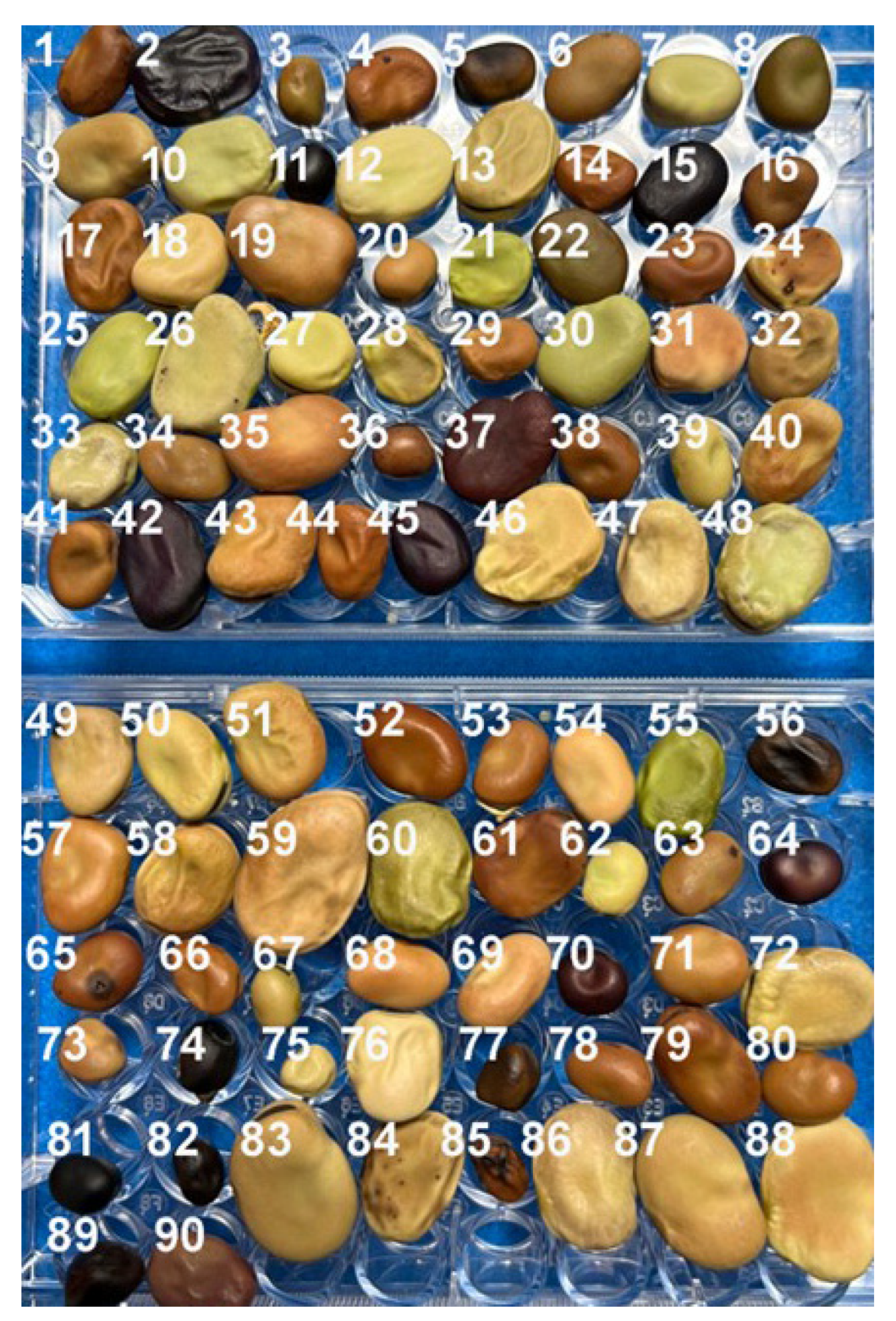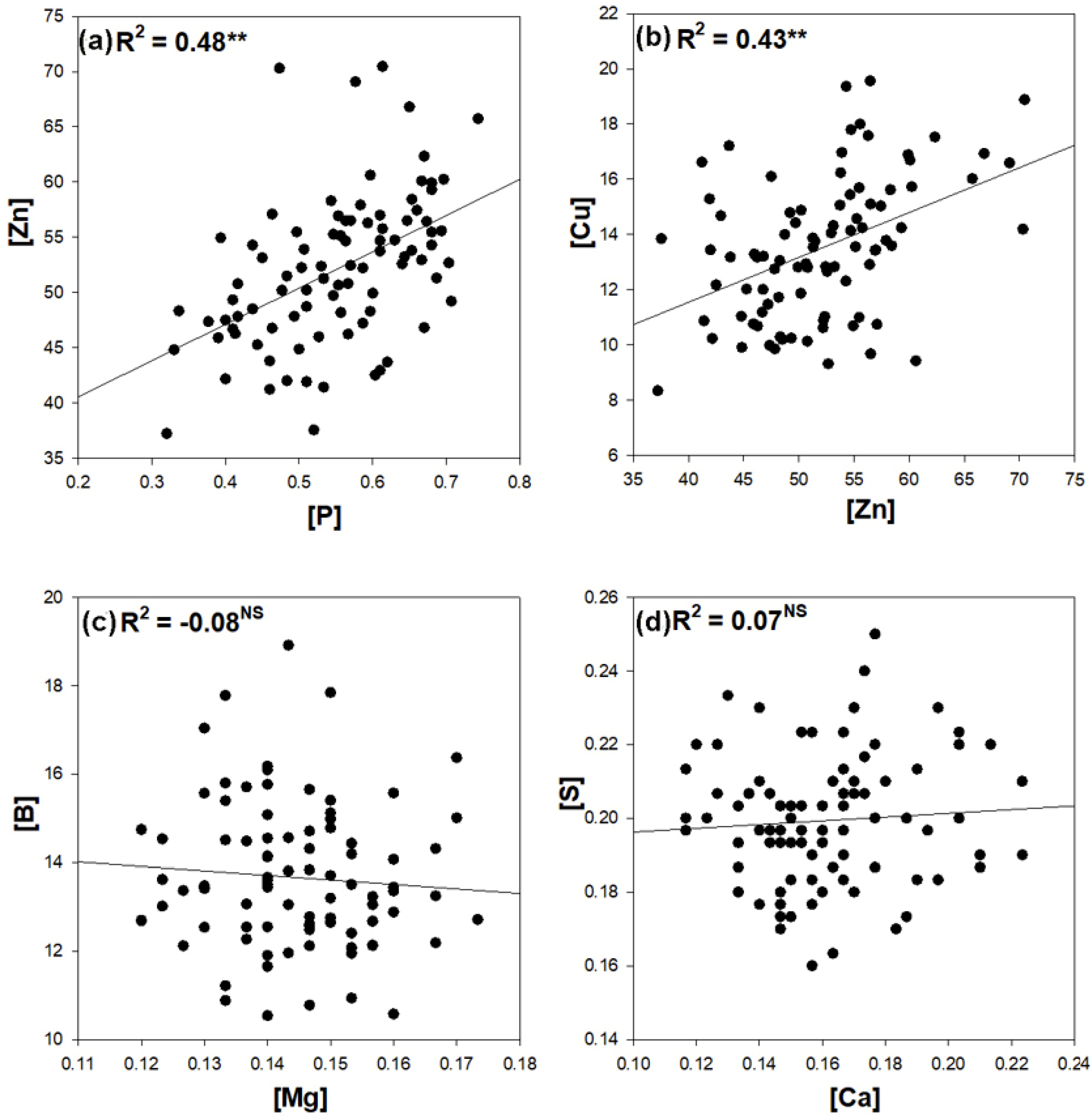Analysis of Nutritional Traits: Natural Variation within 90 Diverse Faba Bean (Vicia faba) Genotypes and Daily Value Contribution
Abstract
1. Introduction
- (i)
- determine the variability of nutrient trait concentrations among 90 faba bean genotypes;
- (ii)
- analyze elemental concentrations and recommended daily values for the mineral nutrients; and
- (iii)
- identify nutrient-dense superior faba bean genotypes for genetic improvement studies and global food challenges.
2. Materials and Methods
2.1. Faba Bean Material
2.2. Elemental Analysis of Mineral Nutrients
2.3. Estimation of Recommended Daily Values (%DV)
2.4. Data Analysis
3. Results
3.1. Phenotypic Variation of Seed Elements
3.2. Correlations among Mineral Nutrients
3.3. Percent Daily Values of Faba Bean Nutrients
3.4. Identification of Promising Top Nine Superior Faba Bean Genotypes
4. Discussion
5. Conclusions
Supplementary Materials
Funding
Data Availability Statement
Acknowledgments
Conflicts of Interest
References
- Duc, G. Faba bean (Vicia faba L.). Field Crops Res. 1997, 53, 99–109. [Google Scholar] [CrossRef]
- FAOSTAT. FAO Statistical Databases; Food and Agriculture Organization of the United Nations: Rome, Italy, 2023; Available online: https://www.fao.org/faostat (accessed on 1 June 2024).
- Hacisalihoglu, G.; Armstrong, P. Flax and Sorghum: Multi-Element Contents and Nut Values within 210 Vars & Pot Selection for Future Climates to Sustain Food Security. Plants 2022, 11, 451. [Google Scholar] [CrossRef]
- Campos, A.C.A.; van Dijk, W.F.; Ramakrishna, P.; Giles, T.; Korte, P.; Douglas, A.; Smith, P.; Salt, D.E. 1,135 ionomes reveal the global pattern of leaf and seed mineral nutrient and trace element diversity in Arabidopsis thaliana. Plant J. 2021, 106, 536–554. [Google Scholar] [CrossRef] [PubMed]
- Hacisalihoglu, G.; Beisel, N.; Settles, A.M. Characterization of pea seed nutritional value within a diverse population of Pisum sativum. PLoS ONE 2021, 16, e0259565. [Google Scholar] [CrossRef] [PubMed]
- Ziegler, G.; Terauchi, A.; Becker, A.; Armstrong, P.; Hudson, K.; Baxter, I. Ionomic screening of field-grown soybean identifies mutants with altered seed elemental composition. Plant Gen. 2013, 6, 1–9. [Google Scholar] [CrossRef]
- Hacisalihoglu, G.; Settles, A.M. Quantification of Seed Ionome Variation in 90 Diverse Soybean (Glycine max) Lines. J. Plant Nutr. 2017, 40, 2808–2817. [Google Scholar] [CrossRef]
- Pinson, S.R.M.; Tarpley, L.; Yan, W.; Yeater, K.; Lahner, B.; Yakubova, E.; Xin-Yuan, H.; Zhang, M.; Guerinot, M.L.; Salt, D.E. Worldwide genetic diversity for mineral element concentrations in rice grain. Crop Sci. 2015, 55, 294–311. [Google Scholar] [CrossRef]
- Wang, M.L.; Grusak, M.A.; Chen, C.Y.; Tonnis, B.; Barkley, N.A.; Evans, E. Seed protein percentage and mineral concentration variability and their correlation with other seed quality traits in the U.S. peanut mini-core collection. Peanut Sci. 2016, 43, 119–125. [Google Scholar] [CrossRef]
- Nadeem, M.A. Exploring the phenotypic diversity for seed mineral contents in Turkish faba bean germplasm. Int. J. Agric. Wild. Sci. 2021, 7, 540–550. [Google Scholar]
- Khazaei, H.; Vandenberg, A. Seed mineral composition and protein content of faba beans (Vicia faba) with contrasting tannin contents. Agronomy 2020, 10, 511. [Google Scholar] [CrossRef]
- FDA. U.S. Food and Drug Administration: Nutrient content claims for “good source”, “high”, “more”, and “high potency”. Code of Federal Regulations. 2014, Subpart D, Title 21, 101.54. Available online: https://www.ecfr.gov/ (accessed on 1 May 2024).
- Labba, I.C.M.; Frokiaer, H.; Sandberg, A.S. Nutritional and antinutritional composition of fava bean (Vicia faba L., var. minor) cultivars. Food Res. Int. 2021, 140, 110038. [Google Scholar] [CrossRef] [PubMed]
- Hacisalihoglu, G.; Kantanka, S.; Miller, N.; Gustin, J.L.; Settles, A.M. Modulation of early maize seedling performance via priming under sub-optimal temperatures. PLoS ONE 2018, 13, e0206861. [Google Scholar] [CrossRef] [PubMed]
- Food and Agriculture Organization of the United Nations. Sustainable Development Goals. 2015. Available online: www.fao.org/sustainable-development-goals/ (accessed on 5 July 2024).




| K | P | Ca | Mg | S | Zn | Fe | Cu | B | Mn | |
|---|---|---|---|---|---|---|---|---|---|---|
| % | % | % | % | % | µg/g | µg/g | µg/g | µg/g | µg/g | |
| Avg. | 1.25 | 0.55 | 0.16 | 0.14 | 0.20 | 52.06 | 77.56 | 13.51 | 13.66 | 17.92 |
| SD | 0.09 | 0.10 | 0.03 | 0.01 | 0.02 | 7.09 | 10.66 | 2.61 | 1.83 | 2.83 |
| Min | 1.04 | 0.31 | 0.10 | 0.12 | 0.15 | 36.82 | 59.29 | 7.83 | 9.53 | 11.93 |
| Max | 1.58 | 0.77 | 0.26 | 0.18 | 0.26 | 85.73 | 124.10 | 20.50 | 21.40 | 26.45 |
| Genotype | Performance | Origin | |
|---|---|---|---|
| GL8 | Highest: P; S | High: Mn | China |
| Brocal | Highest: K | High: P; Mg | Spain |
| Abawi | Highest: K | Peru | |
| NEB341 | Highest: Mg | High: P; Ca; B | Kenya |
| Jahuas | Highest: Ca | High: Mn | Peru |
| 870523 | Highest: Zn | Spain | |
| 1964-10 | Highest: Mn | Ir. | |
| IQ220004 | Highest: Fe | High: K; Cu | Iraq |
| 64-77 | Highest: Cu | High: Mg | USA |
Disclaimer/Publisher’s Note: The statements, opinions and data contained in all publications are solely those of the individual author(s) and contributor(s) and not of MDPI and/or the editor(s). MDPI and/or the editor(s) disclaim responsibility for any injury to people or property resulting from any ideas, methods, instructions or products referred to in the content. |
© 2024 by the author. Licensee MDPI, Basel, Switzerland. This article is an open access article distributed under the terms and conditions of the Creative Commons Attribution (CC BY) license (https://creativecommons.org/licenses/by/4.0/).
Share and Cite
Hacisalihoglu, G. Analysis of Nutritional Traits: Natural Variation within 90 Diverse Faba Bean (Vicia faba) Genotypes and Daily Value Contribution. Crops 2024, 4, 440-446. https://doi.org/10.3390/crops4030031
Hacisalihoglu G. Analysis of Nutritional Traits: Natural Variation within 90 Diverse Faba Bean (Vicia faba) Genotypes and Daily Value Contribution. Crops. 2024; 4(3):440-446. https://doi.org/10.3390/crops4030031
Chicago/Turabian StyleHacisalihoglu, Gokhan. 2024. "Analysis of Nutritional Traits: Natural Variation within 90 Diverse Faba Bean (Vicia faba) Genotypes and Daily Value Contribution" Crops 4, no. 3: 440-446. https://doi.org/10.3390/crops4030031
APA StyleHacisalihoglu, G. (2024). Analysis of Nutritional Traits: Natural Variation within 90 Diverse Faba Bean (Vicia faba) Genotypes and Daily Value Contribution. Crops, 4(3), 440-446. https://doi.org/10.3390/crops4030031






